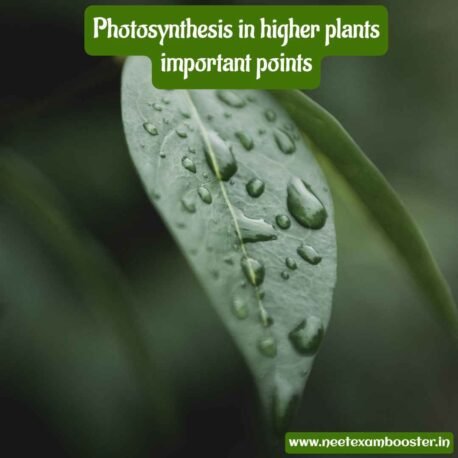Photosynthesis in higher plants important points: Photosynthesis in the higher plants refers to the process by which the plants uses light energy from sun, carbon dioxide from air, and water from soil to produce a compound called glucose (a type of sugar) and oxygen. This process occurs in chloroplasts of the leaf, of plant cells, specifically in chlorophyll present in the thylakoid membranes.
The glucose produced is used as a source of energy and the building material for plant, while oxygen is released into the atmosphere as a by-product. The overall equation for photosynthesis is:
6 CO2 + 6 H2O + light energy → C6H12O6 + 6 O2
where CO2 represents carbon dioxide, H2O represents water, light energy represents the energy from sun, C6H12O6 represents glucose, and O2 represents oxygen.
Photosynthesis in higher plants important points, Photosynthesis in higher plants important points, Photosynthesis in higher plants important points, Photosynthesis in higher plants important points, Photosynthesis in higher plants important points
NCERT Biology Class 11 Chapter 13, 25 important points – Photosynthesis in higher plants important points
There are 25 important points on photosynthesis in higher plants:

1. Occurs in chloroplasts of the green plant cells.
2. Carbon dioxide,CO2 ,is taken in from air through stomata.
3. Uses the sunlight as an energy source.
4. Water is absorbed by the roots and transported to the leaves.
5. Light energy is absorbed by the chlorophyll and the other pigments in the chloroplasts.
6. Light energy is used to split the water molecules into the oxygen and hydrogen ions.
7. Hydrogen ions are used to produce the ATP and NADPH.
8. Carbon dioxide is converted into the glucose through Calvin cycle.
9. Glucose is used as a source of energy and the building material for the plant.
10. Oxygen is released as a by-product of the photosynthesis.
11. Chlorophyll is main pigment involved in the process of photosynthesis.
12. Other pigments, such as the carotenoids and phycobilins, also plays an important role.
13. Light intensity, temperature, and carbon dioxide concentration affects rate of the photosynthesis.
14. Leaves have a large surface area for the maximum light absorption.
15. The stomata regulates the carbon dioxide uptake and water loss.
16. The structure of the chloroplasts and chlorophyll ensures the efficient energy capture.
17. Photosynthesis is essential for survival of most lives on Earth.
18. Photosynthesis provides foundation of the food chain.
19. Photosynthesis produces the oxygen and helps to regulate the Earth’s atmosphere.
20. Photosynthesis is influenced by the environmental factors such as light, temperature, and the atmospheric composition.
21. Some of the plants, such as C4 and CAM plants, have evolved the adaptations to increase the efficiency in low light and high temperatures.
22. Some of the plants can also perform photosynthesis at night using a process called Crassulacean acid metabolism (CAM).
23. Photosynthesis can be limited by the factors such as water stress, nutrient deficiencies, and diseases.
24. Advances in the genetic engineering and biotechnology are increasing our understanding of photosynthesis and its potential for improving the crop yields and sustainable energy production.
25. The study of photosynthesis continues to provide the important insights into the processes that sustains the life on Earth and has wide-ranging implications for the environment, food security, and energy production.
Some Important Questions From Biology Class 11
| Chapter Name | Quiz Link |
| The Living World | Play Now |
| Biological Classification | Play Now |
| Plant Kingdom | Play Now |
| Animal Kingdom | Play Now |
| Morphology of flowering plants | Play Now |
| Anatomy of flowering plants | Play Now |
| Cell: the unit of life | Play Now |
| Biomolecules | Play Now |
| Cell Cycle and cell division | Play Now |
| Transport in Plants | Play Now |
| Structural organisation in Animals | Play Now |
| Mineral nutrition | Play Now |
| Photosynthesis in higher plants | Play Now |
| Respiration in plants | Play Now |
| Plant Growth and development | Play Now |
| Digestion and Absorption | Play Now |
| Breathing and Exchange of Gases | Play Now |
| Body fluids and circulation | Play Now |
| Excretory products and their elimination | Play Now |
| Locomotion and Movement | Play Now |
| Neural Control and Coordination | Play Now |
| Chemical Coordination and Integration | Play Now |
Some Important Questions From Biology Class 12
| Chapter Name | Quiz Link |
| Reproduction in organism | Play Now |
| Sexual reproduction in flowering plant | Play Now |
| Human reproduction | Play Now |
| Reproductive health | Play Now |
| Principles of inheritance and variation | Play Now |
| Molecular basis of inheritance | Play Now |
| Evolution | Play Now |
| Human health and disease | Play Now |
| Strategies for enhancement in food product | Play Now |
| Microbes in human welfare | Play Now |
| Biotechnology principles and processes | Play Now |
| Biotechnology and its application | Play Now |
| Organism and population | Play Now |
| Ecosystem | Play Now |
| Biodiversity and its conservation | Play Now |
| Environment issue | Play Now |



















